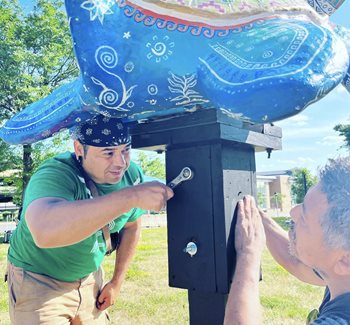During National Arts and Humanities Month, NeighborWorks America offers another look at what organizations do to incorporate arts in their communities.
Dayton's Bluff Neighborhood Housing Services (DBNHS) had several properties they planned to develop – eventually. "But it takes us awhile to raise the funding," explains Executive Director Jim Erchul. So when his organization received a creative placemaking grant from NeighborWorks America, they decided to use the funding to put art on the empty lots. That was five years ago.

"Now, instead of having an empty lot, we've got a sculpture garden," says Erchul
He adds that the artwork gives the community a sense of place – and reflects the diversity of the people who live there. DBNHS has worked with more than 100 artists, all of whom are local. They've also worked to lure an art crawl, centered in the northern part of the city, toward the eastern part, to bring more foot traffic and awareness.
"Native American artists, Latino artists, Black artists. Some of it's dancing and some of it's drumming and some of our art is what the youth call ‘wild style,' like the graffiti you see on box cars. People are expressing their traditions."
This fall, one of Erchul's youth community members summed it up like this: "It's really dope."
Other projects have included storytelling about the Mississippi River, which takes place on an urban farm, and supporting a low-watt radio station. "We're bringing all the different cultures that are on the East Side and we're mixing it up," Erchul says. "Art is a pretty good way of doing that. We're inventing our own style – the East Side style."
Across the NeighborWorks network, about a third have arts programs and partnerships, and Calece
Mary Anne Quiroz appreciated this support when she began working with DBNHS in 2015 after a thrift shop closed in the neighborhood. "We needed space but we didn't have anything brick and mortar," says Quiroz, co-founder of Indigenous Roots. "Jim gave us the canvas." The art installation, which was supposed to last for a weekend, lasted six months and included exhibits, ceremonies, break dance and activism. "They continued to let us work in other open spaces. They've always been supportive of the arts and culture."
Erchul, especially, trusts artists and believes their work is an investment in the neighborhood, "making it more vibrant, welcoming and connected."
Trilingua Cinema is another program that has an art-and-community partnership with DBNHS. At Rivoli Bluff, a site where DBNHS intends to someday build affordable homes, there is now an open field. For the past few summers, Trilingua has shown films there, including a film by a local Hmong filmmaker.
"Last October we did trunk-or-treat [where residents trick-or-treat out of car trunks] and showed a film. We're doing it again this year," says Geordie Flanz, the organization's founder. Trilingua has also shown films at the sculpture site set up by Quiroz.
"East Side is super diverse," says Flanz. "It's still an immigrant community with a lot of vitality." But the communities often remain separate, he says. Projects like the Halloween trunk-or-treat bring them together. "We want to do arts and community development in a way that's responsible and sustainable for the people who live there."

